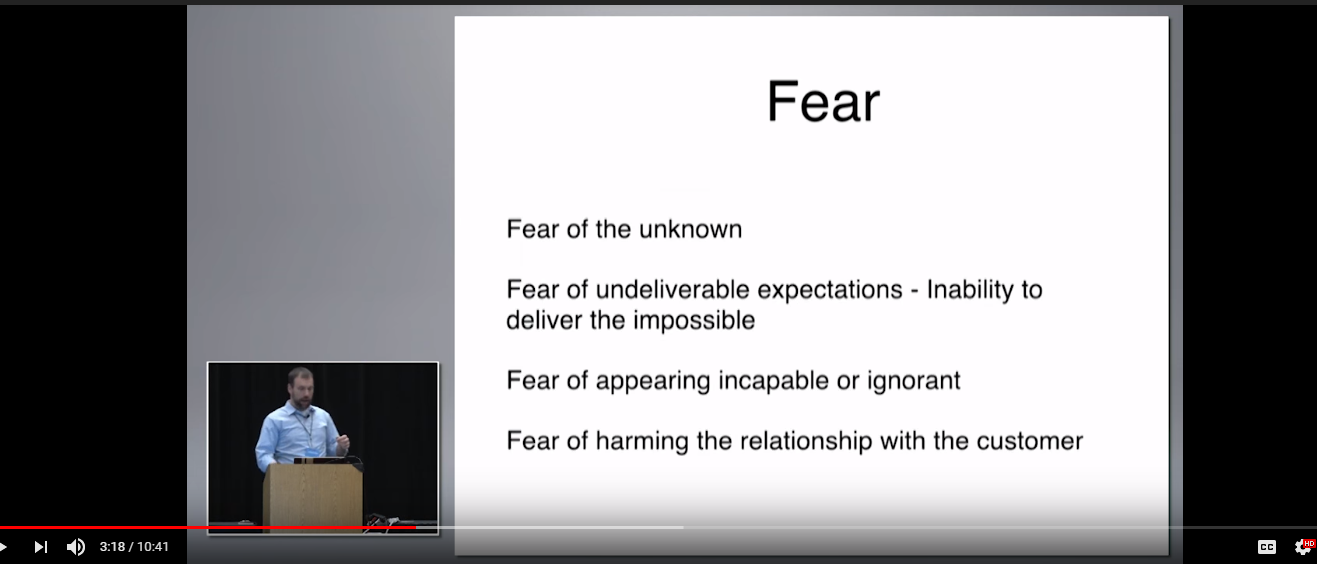Work would be so great if it just wasn’t for the people!
Jonathan Davis shares his own insights into how to approach difficult conversations in work.
Watch Jonathan’s full presentation HERE.
You cannot avoid and delay difficult conversations and make it easier, but the more often you have them, the easier they become.

The anxiety that you feel as you go through them on a regular basis, starts to decline and you begin realizing that the earlier you have them, the better it improves those relationships with customers.
Why are they so difficult?
Ultimately, you want to take pride in your work. We want to produce a product that we’re proud of and we want other people to see. We’re also afraid to lose the reputation that we’ve built for ourselves.

Two things that drive so much of the anxiety that comes along with a difficult conversation:
1. Fear.
When we talk about fear outside of just the reputation impact, it is also:
-Fear of the unknown
-Fear of undeliverable expectations.
There are always those times that we’re dealing with expectations that we cannot handle.
-Fear of appearing and capable or ignorant.
-Fear of harming the relationship with a customer.
2. Pride
If there’s a problem with our design that we implemented, that means that there’s a problem with us.
Then you ask yourself the question: “If you go to a customer site and you weren’t the one who implemented the design that you’re there to fix, tell me all your problems.”
But, if you’re on site and it’s something you designed and implemented, tell me all your problems sounds like, “tell me the ways I failed you.”
Dealing with Pride

The thing that we need to remember is even if you’re responsible for the regional design, there are three things that always take place:
- The technology’s changed in that time period.
- The customer requirements have changed in that time period.
- You’ve changed in that time period.
You’ve changed, you’ve acquired new skills, you’re starting to think about things in a different manner.
You’re going to approach that same problem, that same design from a different perspective.
Bad designs happen
You’re not omniscient. you’re not all-knowing, you don’t know everything right now. All the technology’s always changing.
When you’re dealing with the customer, you’re always talking about the problem, but focus on the resolution. You always need to focus on your energy that takes a little bit of pressure on ourselves.
Halt
- Hungry
- Angry
- Lonely
- Tired
Psychologists use the term halt to describe those moments when we’re not necessarily up to our normal level of experience or maybe we create a bad design.
Have you ever done a design and you’ve been on the road for a long time, it’s 2:00 a.m. and you haven’t eaten since lunch?
This is how bad designs from really expert people have to take place
The other things that we need to always take into account in these situations is “it’s not always about us.”

The customer also feels fear, anxiety and have pride in the game. They don’t understand the technology. They’re looking at you as the expert. They’re afraid of the cost and what that’s going to do to their bottom line that they’ve deferred the solution for so long.
Steps Forward
When we start thinking about steps forward and how to deal with this, number one“just take a breath.” Figure out if you’re feeling “halt” right, or if you’re feeling fine. Decide to figure that out, but then again go back to that hole you’re working towards a resolution.
Strive Towards Resolution
Attempt to make every conversation feel like it’s a conversation between two equals with a focus on the resolution of the difficulty.
Watch Your Language
Leave your jargon at the door. Just to prove the point that we know what we’re doing, we all do it, but be careful what you’re using. This is easy to mess up, not just because of our ego but also just out of habit.
Build a Metaphorical Toolbox of Metaphors

This is one of those ways that you can bridge that gap with a customer. You can explain the technology in a way that they can understand. You can make them feel understand what’s going on in. It doesn’t have to be perfect.
Ask lots of Questions
Ensure that the real problem is being addressed.
Discuss the elephant, not the messy elephants making.
Don’t be Defensive.
Focus on the resolution.
Stick to the facts.
Follow up and follow through.
Summary
Acknowledge your fear and check your ego.
Recognize their pride and fears.
Communicate as equals.
Always work towards the resolution.
Follow-up and follow-through.

Jonathan Davis is a Network Engineer with over 18 years in the Information Technology industry. His specialization in Wireless Networking allows him to bridge his networking career with his love for physics and math.
If you have more questions or feedback, you can check his blog.
Go HERE to watch this entire presentation.

